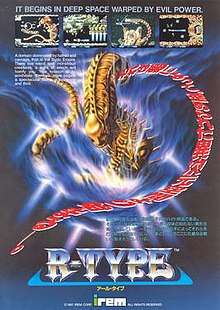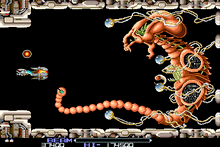R-Type
| R-Type | |
|---|---|
 Japanese arcade flyer | |
| Developer(s) | Irem |
| Publisher(s) | |
| Platform(s) |
Arcade
|
| Release |
July 1, 1987
|
| Genre(s) | Side scrolling shoot-em-up |
| Mode(s) | Single-player, multiplayer |
| Cabinet | Upright |
| Arcade system | Irem M72 |
| Display |
Raster, standard resolution (Used: 384 x 256) horizontal orientation |
R-Type[lower-alpha 1] is a side scrolling shoot-em-up arcade game produced by Irem in 1987. The player controls a space fighter named the R-9 to defend humanity against a mysterious powerful alien life-form known as the "Bydo".
R-Type was ported to various home platforms, and several of its versions including the arcade original have since been re-released on more contemporary consoles. Both the arcade game and the ports were well received by video game magazines. It has spawned a series of sequels by Irem and inspired several video games from other companies.
Gameplay

The game is composed of several sequential levels, with a boss enemy at the end of each. The player controls a small spacecraft and must navigate terrain and fight enemies using the various ship weapons. The player's spacecraft has, by default, a weak but rapid-firing main gun; and a more powerful gun called a wave cannon, which requires the player to hold their fire to build up power for the cannon.
During the game, the player can obtain an auxiliary device called a Force. This resembles a glowing orange ball. The Force can be attached to the front or back of the player's spacecraft, or detached to fly freely. When attached, the Force provides one of three different powerful weapons, in addition to the main gun and the wave cannon.
When detached, these weapons cannot be used, but the Force will instead resort to a secondary set of guns, which can be fired by the player even if the Force is at a distance from the spacecraft. The Force has a secondary use as a shield; it is completely indestructible and can block most things fired at it, as well as damage or destroy enemies on contact.
The R- in the series title stands for "ray", as in a ray of light, in reference to the many different types of ray-like weapons that players use in the series.[2] Another theory suggests that "R-Type" refers to Bydo as r-strategists in r/K selection theory.[3]
Reception
| Reception | ||||||||||||||||
|---|---|---|---|---|---|---|---|---|---|---|---|---|---|---|---|---|
| ||||||||||||||||
| ||||||||||||||||
The original R-Type was well received by most gaming critics. However, it was also infamous for its relentless difficulty.[10] The gameplay of R-Type is noticeably distinct among shoot 'em ups. Invariably the player will lose, not because of an inequality in firepower, but because of the design of the levels themselves. There is usually a 'correct' way to get through a level, but players must learn these by experience - i.e. by losing and restarting from earlier in the level. The game innovated with its weapon system compared to contemporary shooters, featuring a chargeable shot ("beam-meter"), and detachable 'force' pod; levels were designed to require different tactics and ideal weapons (air-to-air, diagonal bouncing lasers, or air-to-ground laser).
The ZX Spectrum version of R-Type was awarded 9/10 in the January 1989 issue of Your Sinclair[11] and was placed at number 6 in the Your Sinclair official top 100. The Games Machine praised the "incredible use of colour" and that it "blows away almost every other shoot'em up on the Spectrum". Crash congratulated Electric Dreams for "retaining the frenetic arcade feel and producing such a brilliant game". Sinclair User praised the weapons system and difficulty curve. C+VG concluded their review by saying "an excellent shoot'em up that's both challenging and addictive. An absolute must for Spectrum blasting fanatics". R-Type was placed number 1 in RGTV's YouTube video "Top 5 Shoot 'em ups on the ZX spectrum".
A successful 1988 port to the Master System was immediately recognized as one of the best games available in the Sega library. A Mean Machines magazine review praised in particular the graphics and the high quality of the challenge offered by the game, awarding it an overall rating of 92%.[12]
A 1995 article in Next Generation stated that the "PC Engine conversion of Irem's arcade smash R-Type is still regarded as the system's definitive contribution to the shoot 'em up genre."[13] The following year they listed both it and the arcade original (but not any other ports of the game) at number 98 in their "Top 100 Games of All Time", praising its art direction, graphics, design innovations, and huge bosses.[14]
The game was runner-up in the category of Best Coin-Op Conversion of the Year at the Golden Joystick Awards, behind Operation Wolf.[15]
Ports
A fairly accurate port of R-Type was released for the PC Engine and TurboGrafx 16 consoles, although both versions suffered from a slightly lower resolution, reduced colour palette, sprite flickering and slowdown. Due to the slightly reduced resolution, the playfield also scrolls slightly in the vertical axis whenever the player's ship approaches the top or bottom of the screen. The Japanese release for the PC Engine was split across two game cards (HuCards) titled R-Type I (アール・タイプI Āru Taipu Wan) and R-Type II (アール・タイプII Āru Taipu Tsū)[16][17] and the later North American release for the TurboGrafx-16 contained the entire game on a single card.[18] The PC Engine version of R-Type is notable for having a boss at the end of Stage 6, rather than a prolonged wave of enemies as in all other versions.
The Xbox Live Arcade game R-Type Dimensions was released on February 4, 2009. It is a port of the original R-Type and the sequel R-Type II. It can be played either with the original 2D graphics or with new 3D graphics, and has added co-op gameplay functionality. An analogous version for PS3 has been released in May, 2014 under the name "R-Type Dimensions".[19]
The PC Engine version of R-Type was one of the first games confirmed for Nintendo's Virtual Console.[20] The North American and European versions include all eight levels as it was released for the TurboGrafx-16.[21][22][23] The Japanese release for the Wii is split between two downloads, mirroring the original format of the game for the PC Engine.[20][24] However, the Japanese releases for the Nintendo 3DS and Wii U use the TurboGrafx-16 version. [25][26]
A Sega Master System version became available as well on the Virtual Console for Japan on May 19, 2009, for North America on November 2, 2009 and for Europe on September 25, 2009; however, due to licensing issues, this version was delisted on September 30, 2011 in North America and Europe[27] and October 18, 2011 in Japan.
In 2010, DotEmu developed an iOS port of R-Type, published by Electronic Arts, released also for Android in September 2011.
Sequels and legacy
Irem has developed a number of sequels and related games, including R-Type II and Armed Police Unit Gallop. Their XMultiply, although not part of the series, has similar themes and gameplay, and was released around the same time as R-Type II. However, before any of these games was Katakis, a 1988 clone produced by Factor 5 for the Commodore 64 and the Amiga.
In 1991, Konami released Xexex, a game heavily influenced by R-Type and XMultiply. The game used similar weapons and concepts, such as the "Flint" being a combination of R-Type Force and X Multiply tentacle equipment.
Other games similar to R-Type are Rezon, released by Allumer in 1991,[28] and Technosoft's 1992 title Thunder Force IV for the Sega Mega Drive.
Adaptations
- An R1 Fighter, from R-Type, is one of the video game characters adapted for the manga Warera Hobby's: Famicom Seminar (われらホビーズファミコンゼミナール Ware-ra Hobīzu Famikon Zemināru) from 1988 to 1990.
- R-Type is one of the video games featured in the manga Rock'n Game Boy, by Shigeto Ikehara, which was published by Comic BomBom from October 1989 to December 1991.
Notes
References
- ↑ "This Week's Downloadable Lineup Truly Sparkles". Nintendo of America. 2 November 2009. Retrieved 2009-11-03.
- ↑ "R-type developer interview". Gamest. 13. 1987.
- ↑ "R-Type". Hardcore Gaming 101.
- ↑ http://www.worldofspectrum.org/showmag.cgi?mag=C+VG/Issue085/Pages/CVG08500021.jpg
- ↑ http://www.worldofspectrum.org/showmag.cgi?mag=Crash/Issue59/Pages/Crash5900027.jpg
- ↑ http://www.worldofspectrum.org/showmag.cgi?mag=SinclairUser/Issue081/Pages/SinclairUser08100091.jpg
- ↑ "R-Type". ysrnry.co.uk. Archived from the original on June 26, 2015. Retrieved September 4, 2015.
- ↑ http://www.worldofspectrum.org/showmag.cgi?mag=ACE/Issue15/Pages/ACE1500050.jpg
- ↑ http://www.worldofspectrum.org/showmag.cgi?mag=TheGamesMachine/Issue15/Pages/TheGamesMachine1500035.jpg
- ↑ "Top 10 Tuesday: Toughest Games to Beat - IGN". ign.com. Retrieved 2015-09-04.
- ↑ "R-Type". ysrnry.co.uk. Archived from the original on June 26, 2015. Retrieved September 4, 2015.
- ↑ Mean Machines, Issue 7, April 1991, pp.88-90
- ↑ "Hudson Soft". Next Generation. No. 3. Imagine Media. March 1995. p. 78.
- ↑ "Top 100 Games of All Time". Next Generation. No. 21. Imagine Media. September 1996. p. 38.
- ↑ http://www.worldofspectrum.org/showmag.cgi?mag=C+VG/Issue092/Pages/CVG09200062.jpg
- ↑ "Video Game Den". Video Game Den. Retrieved 2011-08-13.
- ↑ Chronological list of PC Engine games
- ↑ "R-Type". Hardcore Gaming 101. Retrieved 2011-08-13.
- ↑ "R-Type Dimensions Out Today on PS3 – PlayStation.Blog". blog.us.playstation.com. Retrieved 2015-09-04.
- 1 2 https://www.nintendo.co.jp/wii/vc/software/01.html
- ↑ https://www.nintendo.com/games/detail/OCr2wiKRWJG9UkRWr6hLHPtkzTfNYLfr
- ↑ https://www.nintendo.com/games/detail/r-type-wii-u
- ↑ https://www.nintendo.co.uk/Games/TurboGrafx/R-TYPE--278689.html
- ↑ https://www.nintendo.co.jp/wii/vc/software/02.html
- ↑ https://www.nintendo.co.jp/titles/50010000020157
- ↑ https://www.nintendo.co.jp/titles/20010000006528
- ↑ http://www.siliconera.com/2011/09/28/last-chance-to-grab-r-type-off-the-wii-virtual-console/
- ↑ "Rezon Videogame by Taito/Allumer (1991) - The International Arcade Museum and the KLOV". klov.com. Retrieved 2015-09-04.
External links
- R-Type at GameFAQs
- R-Type at Giant Bomb
- R-Type at Killer List of Videogames
- R-Type at MobyGames